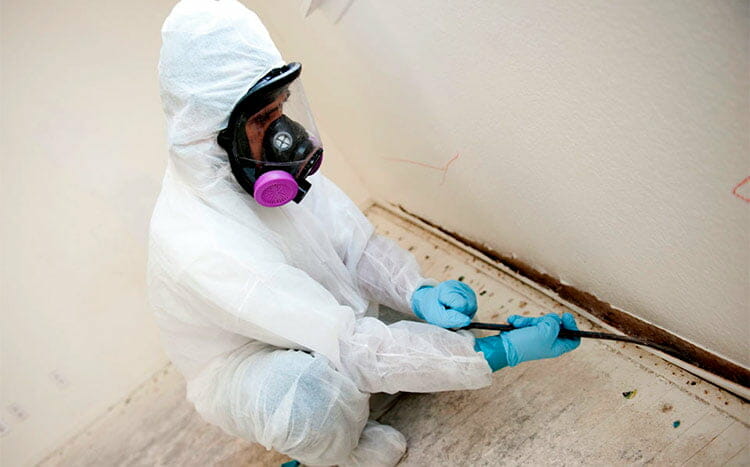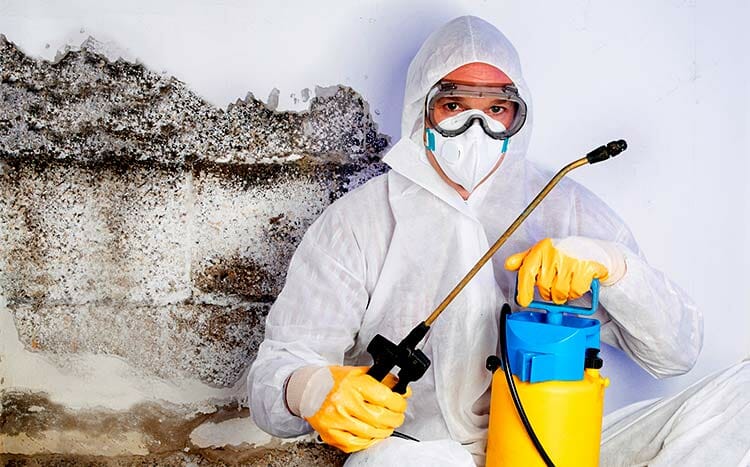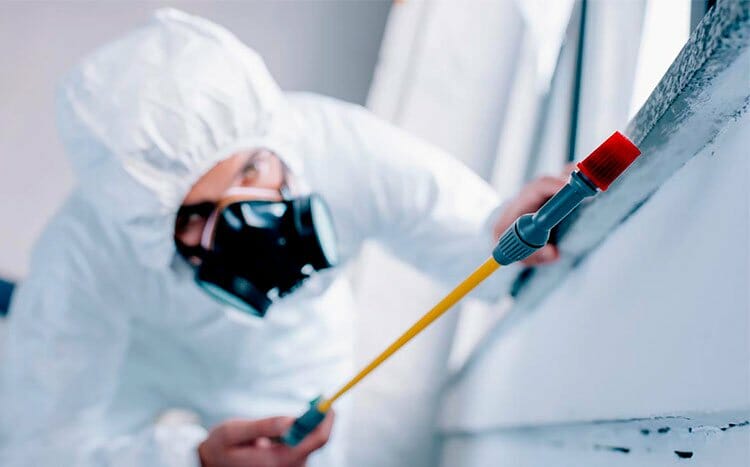Mold remediation involves a comprehensive cleaning process aimed at reducing mold levels in your home to manageable amounts. An experienced mold removal expert can carry out mold remediation in any part of your home affected by mold. Despite the diverse manifestations of mold damage, the strategies for mold management remain the same.
Mold can return after remediation if the source of moisture causing the mold problem is not identified and resolved. Unrepaired leaking roofs, pipes, and broken window seals are familiar sources of moisture, creating indoor damp spots that will continue to attract mold even after remediation.
Mold remediation should not be confused with mold removal. Mold remediation is the complete removal of both mold and contaminated material, such as drywall and insulation. In contrast, the latter is merely removing mold growth from contaminated surfaces.

Why does mold come back?
Mold will return to recently remediated surfaces if the conditions that promote mold growth are still present. Mold remedial without resolving the underlying issues nurturing its development means that the mold problem will only go away for a while. The factors that encourage the return of mold to areas where you have previously performed mold remediation include:
- Existing mold spores: an effective mold remediation job should eliminate mold spores. But the truth is, they are notoriously difficult to eradicate. Mold spores are microscopic fungi that range from 3 to 40 microns. They are present everywhere and can lie dormant (but alive) for a long time while waiting for favorable conditions that would allow them to grow and multiply. Mold spores can eat into porous surfaces such as wood, survive and regrow, even after mold remediation.
- Moisture: unresolved moisture problems resulting from piping leaks, flooding, and high humidity are significant reasons for the return of mold to remediated spaces. The majority of mold species require some moisture to thrive, and areas with consistent water activity are prone to mold resurgence.
- Suitable temperatures: mold thrives in room temperature levels. This implies that the warm and mild temperatures most suitable for human existence also favor the growth of mold colonies.
- Food: the presence of organic substrate stimulates mold to return to previously remediated surfaces when all other factors are present. Mold feeds on substances containing carbon atoms, and organic compounds such as soap and shampoo scum, dirt, fibers from fabric, wood substrate, even bodily oils serve as sources of nutrient for mold.
Use this FREE service
HomeGardenGuides.com is a free service that quickly matches you with top-voted local mold remediation companies.
You can get three estimates fast by real certified experts in your area in just 2 minutes.
- Scroll to the top of the page and enter your Zip code.
- Answer questions about your mold remediation job.
- Your project details are forwarded to three local experts. They will send you a price estimate for the job and some friendly advice.
IMPORTANT: There is no obligation to hire. This is a free tool and service to be used at your pleasure.

How to keep mold from coming back?
Mold can regrow on remediated areas if the mold spores generated by the last colony aren’t eliminated or the conditions that facilitate mold growth persist. Several mold removal guides provide detailed information about remediation techniques and how to prevent the return of mold after remediation. Use the following tips to prevent mold from returning to previously remediated areas.
Tip 1. Maintain low post-remediation indoor humidity levels
Keeping your indoor humidity below pre-mold remediation levels can help to reduce the odds of mold returning after removal. Homeowners can measure the frequent shifts in indoor humidity levels with a hygrometer and regulate air conditioners and dehumidifiers accordingly to keep humidity to minimum levels.
Tip 2. Allow dryers and fans to vent outside.
Exhaust fans encourage the circulation of cool, dry air within the home interior by extracting warm, moisture-heavy air from bathrooms and kitchens. However, your home exhaust fan must be designed to vent outside. This will prevent the air condensation inside the vent ducts from causing damp conditions that stimulate mold growth.
Tip 3. Repair all leaks
Damaged pipes, leaking roofs, and deteriorated window seals all contribute to damp indoor spite. These are the causes of moisture build-up within the home that encourage mold growth. Prompt repair of all leaking pipes, roofs, window seals, and cracked walls is key to avoiding persistent damp conditions that promote the return of mold after remediation.
Tip 4. Kill all mold spores
Use mold-killing cleaning agents such as vinegar, bleach, or alcohol when removing mold from bathrooms and basements. Eliminating mold spores reduces the chances of mold returning to areas previously declared free from mold.
Tip 5. Use anti-fungal paint on mold-prone areas
It is always a good idea to cover damp areas with mold-resistant paint.
Tip 6. Hire a professional
A certified mold removal specialist is your best bet for eliminating mold from your home. Mold specialists are trained in mold remediation techniques, they are capable of deploying the required equipment, and they adhere to safety protocols to clean up mold without the risk of contamination.
What to look for in a mold remediation company?
Commercial mold remediators are required by Environmental Protection Agency (EPA) regulations to clean up mold exceeding 10 square feet. They are also expected to observe cleanup guidelines and recommendations issued by professional organizations such as the American Conference of Governmental Industrial Hygienists (ACGIH) and state and local mold remediation laws.
According to the EPA, mold remediation companies must have the equipment and the experience to perform the following tasks:
- Perform mold remediation in schools, government, and commercial buildings.
- Clean mold from contaminated air ducts and vents in HVAC systems.
- Successfully remediate mold damage in buildings with raw sewage or contaminated water.
Mold remediation companies are expected to conform to best industry practices and regulations. Ensure that the mold remediation company you’re hiring possess the following requirements
- Liability insurance: A mold remediation company must possess a liability policy covering any injury or damage to you or your property by the company workers during the mold remediation job. The company’s liability policy should also shield you from potential liability arising from injuries sustained by a company employee while working on your property.
- Certification – Certifications signify competence and ensure that the company policies conform to industry standards. A reputable mold remediation company should be certified by the relevant government and non-government organizations to remove mold.
- Experience – You need to confirm that the company has significant experience in mold remediation before hiring. Please find out how long they’ve been in business and ask to see previous mold remediation jobs. Ask for references and follow them up. Inquire about their remediation techniques, mold testing procedures, job site protocols, and the quality of their employees.
- Safety standards – mold containment or removal is a hazardous job. A reputable mold remediation service must have in-house safety protocols that prevent mold contamination on project sites. Confirm the existence of any safety checklist for workers and other essential safety equipment. Find out if they have mold containment procedures. If they do, request a written copy or a verbal explanation.
- A written contract – a company that doesn’t provide you with a written and signed agreement isn’t likely to honor its obligations. A written agreement typically includes the following:
- The scope of work.
- The job completion timeline.
- Clean up protocol
- A mold removal guarantee.

What paint should I use after mold remediation?
You can cover recently remediated surfaces with mold-resistant paint to provide an aesthetically pleasing and flawless interior wall finish without compromising practicality and safety. Mold-resistant paint is formulated with antimicrobial properties, which does an excellent job of protecting remediated spots from recurring mold problems. Mold-resistant paint products have a typical lifespan of five to six years; they are non-toxic and are relatively inexpensive. You can buy several mold-resistant paints at hardware and home improvement stores in flat, gloss, semi-gloss, and satin finishes.
Benefits of using mold resistant paint include:
- It is an effective and safer mold inhibiting solution compared to other methods like encapsulation.
- The application process is faster, easier, and tidy.
- It offers remediated surfaces long-term protection against mold regrowth.
- It is non-toxic and can be used in living areas.
- You can easily cover mold-resistant paint with regular paint.
- It is highly effective in poorly ventilated interior spaces with high moisture levels, such as the bathrooms, kitchens, and basements.
Painting tips
- Experts recommend prepping (cleaning) mold-infested areas with antimicrobial cleansers to kill off mold spores before applying mold-resistant paint.
- Ensure that remediated surfaces are clean, dry, and mold-free before applying mold-resistant paint.
- Apply liberal amounts of mold-resistant paint to the top and bottom corners of wall joints. These are the areas on the wall surface that are most susceptible to mold growth.
- You can use antifungal sealants to encapsulate small amounts of mold remaining after the remediation process before applying mold-resistant paint.
How long after remediation can mold come back?
The odds of mold coming back or how quickly it will return after remediation depends on whether (or how) the mold removal specialist (or you) fixed the moisture source responsible for the mold growth. A mold colony can start growing between 24 to 48 hours after a mold spore lands on a damp spot. If the source of the dampness is eliminated, then the wet conditions that allow mold to thrive will not exist. However, mold may return to remediated areas in 48 hours if the moisture issue is left unaddressed.
What are the first signs of mold coming back after remediation?
Under normal circumstances, mold remediation should take care of mold – forever. However, remediation scams are pretty rife, and not all remediation jobs are adequately done. If you see the following signs after remediation, then mold has returned, and you should call a mold inspector to confirm the location of the mold growth.
The signs include:
- Bubbled, cracked, and peeling wallpaper or wall paint.
- Warped or bulging walls.
- Discoloration or water stains on ceilings, walls, and floors signify mold growing beneath these spaces.
- If you suffer allergic symptoms associated with mold exposure whenever you are indoors. These include:
- Runny nose.
- Itchy or runny eyes.
- Intense sneezing.
- Coughing fit and breathing difficulty.
- Skin irritation.
- You can mostly always perceive mold before you see it. Most mold species give off a musty, earthy odor that you can easily smell.
FAQ's
Is it safe to live in a house after mold remediation?
Yes, it is provided the mold has been reduced to safe levels. The point of performing mold remediation is to make the house safe for people to reside in. However, it depends on the quality of the remediation job. If the mold remediation fails to remove significant amounts of mold, then the house may not be considered safe to reside in.
What chemicals are used for mold remediation?
A variety of chemicals are commonly used for mold remediation. Examples include; hydrogen peroxide, chlorine (bleach-based), ammonium compounds, alcohol, iodophors (iodine), phenolics, and formaldehyde-based chemical products.







